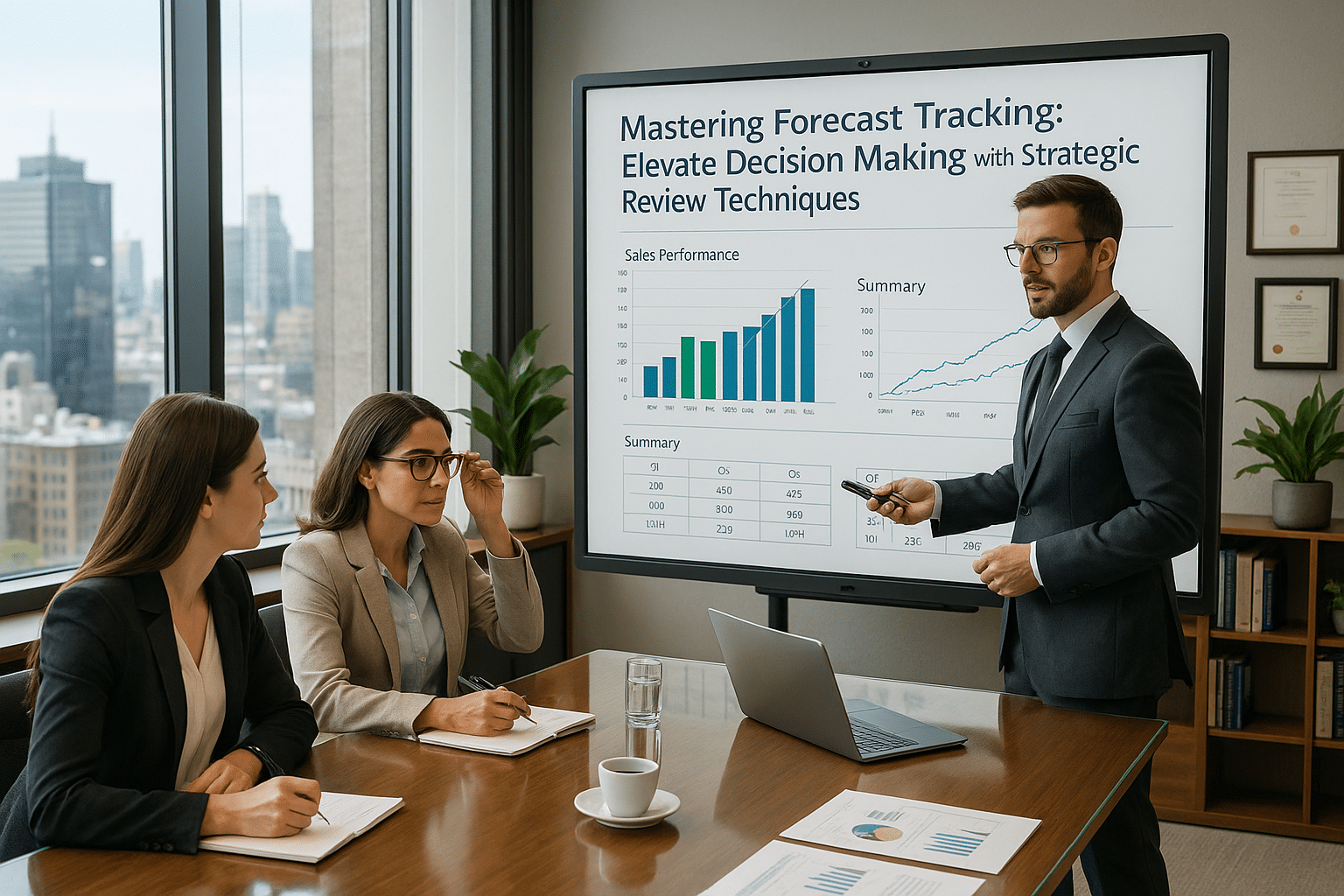They work silently, often unappreciated, but are crucial for effective decision making and business success. In this piece, we will demystify these concepts, lay bare their importance, and walk you through the process of mastering them. 🎯
Forecast tracking, in a nutshell, is the process of predicting future outcomes based on past and present data. It’s like having a crystal ball that tells you the probable future of your business. 💼🔮 But unlike the mythical crystal ball, forecast tracking is rooted in science, statistics, and logic. And just like any other science, it can be mastered with the right tools and techniques, and a dash of patience and persistence.
The primary focus of this article is to provide you with a deeper understanding of forecast tracking, its role in strategic decision making, and the techniques that can be used to elevate its effectiveness. So whether you’re a seasoned executive, an aspiring entrepreneur, or a curious student of business, this piece is sure to provide valuable insights. 🎓💡
At the heart of every successful business is an effective decision-making process. And strategic review techniques are a key component of this process. These techniques offer a systematic approach to review and assess the strategies of a business. They help businesses to learn from their past, make sense of the present, and prepare for the future. 🔄🚀
Article Overview
As we venture deeper into the topic, we will initially focus on defining forecast tracking and strategic review techniques in detail. This will include a look at different types of forecasting, its process, and the role it plays in decision making. We will then discuss the connection between forecast tracking and strategic decision making, highlighting their symbiotic relationship. 🔄
Subsequently, we will dive into the core of the subject – mastering these techniques. This section will be filled with practical advice, proven methodologies, and case studies to provide a comprehensive guide on how to elevate your decision-making process using forecast tracking and strategic review techniques. 📚🛠️
Finally, we will provide an overview of some commonly used tools and software in forecast tracking. From simple spreadsheet-based solutions to sophisticated software suites, we will guide you through the maze of available options, helping you choose the best tool for your specific needs. 💻🔧
In essence, this article is your guide to elevate your decision-making process. It will equip you with the knowledge and tools needed to make informed, strategic decisions that will drive your business forward. So, buckle up and get ready for a journey into the world of forecast tracking and strategic review techniques. 🌐🚀
Let’s dive right in! 🏊♂️
Understanding the Concept of Forecast Tracking
Forecast tracking is a crucial practice that businesses and organizations implement to understand future scenarios. This technique helps in planning, decision making, and evaluating the likelihood of future events. By mastering forecast tracking, you can elevate your decision-making process through strategic review techniques.
This article will discuss the significance of forecast tracking, explain how to master it, and explore various strategic review techniques to improve decision-making. We will delve into different forecasting methods, comparison between them, and how to use these methods in various business situations.
Before we dive in, it would be beneficial to watch the following YouTube video “The Art of Forecasting – What You Need to Know” by the Stanford Graduate School of Business to get a comprehensive understanding of forecasting.
Role of Forecast Tracking in Strategic Decision Making
Forecast tracking is not merely about predicting future numbers. It also involves the careful analysis of these numbers to make strategic decisions. Businesses use this technique to anticipate changes in the market, evaluate business strategies, and make informed decisions.
For instance, a company might use sales forecasting to predict its future revenue. This information can then guide the company’s budgeting decisions, helping it allocate resources more effectively. Similarly, a company might use forecast tracking to predict market trends, helping it determine which products or services to prioritize.
Understanding forecast tracking is a powerful tool in decision making. By mastering this technique, businesses can make more informed decisions, improve their strategic planning, and gain a competitive edge in the market.
Key Techniques for Mastering Forecast Tracking
The process of mastering forecast tracking requires an understanding of several techniques. These include qualitative and quantitative forecasting, time series analysis, and trend projection.
Qualitative forecasting relies on expert opinions and does not involve numerical data. It is often used when historical data is not available or when the forecast is based on subjective factors like consumer preferences. On the other hand, quantitative forecasting uses mathematical models and historical data to predict future trends.
Time series analysis is a statistical technique that analyzes data over a specific period to identify patterns and trends. This method is beneficial for long-term forecasting. Trend projection, as the name suggests, involves analyzing historical trends to predict future patterns. This method is particularly useful for predicting market trends.
Here’s a YouTube video that provides a deeper understanding of these techniques: “Quantitative vs. Qualitative Forecasting: What’s the Difference?” by CFI Education.
Comparative Analysis of Forecasting Techniques
Understanding the strengths and weaknesses of each forecasting method is essential for effective forecast tracking. The following table provides a comparative analysis of the different forecasting techniques:
| Forecasting Technique | Strengths | Weaknesses |
|---|---|---|
| Qualitative Forecasting | Useful when historical data is not available Helps understand subjective factors |
Dependent on expert opinions Can be influenced by biases |
| Quantitative Forecasting | Provides objective predictions Uses historical data |
Not useful for short-term predictions Doesn’t consider external factors |
| Time Series Analysis | Useful for long-term predictions Helps identify patterns and trends |
Requires a large amount of data Can be complex to implement |
| Trend Projection | Useful for predicting market trends Relies on historical data |
Doesn’t consider sudden changes in trends May not be accurate for long-term predictions |
Remember, no single forecasting technique is perfect for all situations. The choice of method depends on the nature of your business, the available data, and the specific scenario you are forecasting.
Implementing Forecast Tracking: Steps and Tips
Implementing forecast tracking in your business involves several steps. Here’s a brief overview:
- Identify the objective of the forecast
- Select the appropriate forecasting technique
- Gather and analyze relevant data
- Create the forecast
- Review and adjust the forecast as needed
Additionally, here are some tips to help you master forecast tracking:
- Use multiple forecasting techniques to cross-check your predictions
- Ensure your forecasts are flexible and can be updated as new data becomes available
- Regularly review and adjust your forecasts to improve their accuracy
To further expand your knowledge on forecast tracking, don’t forget to watch this insightful YouTube video, “How to Forecast Using Excel” by Leila Gharani.
Final Thoughts on Mastering Forecast Tracking
Mastering forecast tracking is a journey that requires understanding, practice, and continuous improvement. By leveraging different forecasting techniques and regularly reviewing your forecasts, you can elevate your decision-making process and steer your business towards success.
Remember, the key to successful forecast tracking is not just about making accurate predictions, but also about using these predictions to make strategic decisions. So, keep learning, keep experimenting, and keep improving!
Don’t forget to check out more articles on this blog to expand your knowledge about strategic decision making and forecasting techniques.

Conclusion
In conclusion, this article has endeavored to clarify and elaborate on a broad array of subjects, all of which encompass the realms of IT and engineering. We began with a comprehensive introduction to the basic principles of software engineering, delineating the importance of design patterns, and how they can drastically augment the efficiency of a developer’s workflow.💻
Following this, we delved into the integral role of Big Data in the contemporary world, and how it has revolutionized the landscape of virtually all industries, from healthcare to finance. The power of Big Data, as we discovered, is not just in its sheer volume but in its potential for analysis and actionable insights. 📈
We also discussed the significance of cloud computing, an indispensable tool in the arsenal of modern businesses. The shift from traditional on-site servers to the cloud has not only provided unprecedented accessibility but also a level of scalability that was unimaginable in the past. ☁️
Moreover, we traversed the fascinating world of artificial intelligence (AI) and machine learning (ML). We underscored the omnipresence of these technologies in our daily lives, from personalized recommendations on Netflix to voice assistants like Alexa and Siri. We highlighted that the real power of AI and ML lies in their capability to learn and improve autonomously, heralding a new era of innovation. 🤖
Finally, we explored the criticality of cybersecurity in an increasingly digital world. We stressed the need for robust security measures to protect sensitive information and maintain the integrity of IT systems.🔒
By thoroughly understanding these topics, we hope to empower our readers with the knowledge necessary to navigate the complex landscape of technology and engineering. These domains, while intricate and challenging, are profoundly transformative and offer limitless opportunities for those willing to engage with them.
We hope that this comprehensive exposition has been enlightening and has instilled in you a deeper understanding of these topics. Knowledge is power, and in the realm of IT and engineering, it is your most potent tool. So, do not hesitate to revisit these concepts, delve deeper into each subject, and keep updating your knowledge. 🧠
We encourage you to share this article with your peers, to foster a community of learning and collaboration. Feel free to leave your thoughts, comments, or any queries you might have in the comment section below.
For further reading, you can check out these articles on software engineering, big data, cloud computing, AI and ML, and cybersecurity.
Thank you for investing your time in reading this article. Remember, the future belongs to those who believe in the beauty of their dreams and dare to turn them into reality. Keep learning, keep growing. 🚀
References:
- Software Engineering Article Source
- Big Data Article Source
- Cloud Computing Article Source
- AI and ML Article Source
- Cybersecurity Article Source
Remember, “The more that you read, the more things you will know. The more that you learn, the more places you’ll go.” – Dr. Seuss. 🎓



